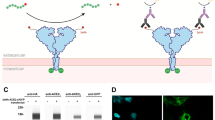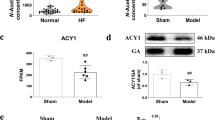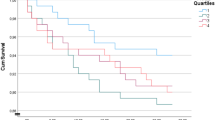Abstract
The renin-angiotensin (Ang) system plays a critical role in the regulation of blood pressure, body fluid, electrolyte homeostasis, and organ remodeling under physiological and pathological conditions. The carboxy-peptidase ACE2 is a homologue of angiotensin-converting enzyme (ACE). It has been reported that ACE2-deficient mice develop cardiac dysfunction with increased plasma levels of Ang II. However, the molecular mechanism by which genetic disruption of ACE2 results in heart dysfunction is not fully understood. Here, we generated mice with targeted disruption of the Ace2 gene and compared the cardiovascular function of ACE2–ly mice with that of their wild-type littermates. ACE2-deficient mice were viable and fertile and lacked any gross structural abnormalities. Echocardiographic study detected no functional difference between ACE2–ly and wild-type mice at 12 weeks of age. Twenty-four-week-old ACE2–ly mice displayed significantly enlarged hearts with impaired systolic and diastolic function. The Ang II level was elevated in the plasma and heart of ACE2–ly mice. Pharmacological blockade of Ang II type 1 receptor (AT1) with candesartan attenuated the development of cardiac dysfunction in ACE2–ly mice. These results suggest that enhanced stimulation of AT1 may play a role in the development of cardiac dysfunction observed in ACE2-deficient mice.
Similar content being viewed by others
Article PDF
References
Morimoto S, Yano Y, Maki K, Sawada K : Renal and vascular protective effects of telmisartan in patients with essential hypertension. Hypertens Res 2006; 29: 567–572.
Takada J, Ibayashi S, Ooboshi H, et al: Valsartan improves the lower limit of cerebral autoregulation in rats. Hypertens Res 2006; 29: 621–626.
Kim-Mitsuyama S, Izumi Y, Izumiya Y, Yoshida K, Yoshiyama M, Iwao H : Additive beneficial effects of the combination of a calcium channel blocker and an angiotensin blocker on a hypertensive rat-heart failure model. Hypertens Res 2004; 27: 771–779.
Tipnis SR, Hooper NM, Hyde R, Karran E, Christie G, Turner AJ : A human homolog of angiotensin-converting enzyme. Cloning and functional expression as a captoprilinsensitive carboxypeptidase. J Biol Chem 2000; 275: 33238–33243.
Donoghue M, Hsieh F, Baronas E, et al: A novel angiotensin-converting enzyme-related carboxypeptidase (ACE2) converts angiotensin I to angiotensin 1–9. Circ Res 2000; 87: E1–E9.
Crackower MA, Sarao R, Oudit GY, et al: Angiotensinconverting enzyme 2 is an essential regulator of heart function. Nature 2002; 417: 822–828.
De Mello WC, Danser AH : Angiotensin II and the heart: on the intracrine renin-angiotensin system. Hypertension 2000; 35: 1183–1188.
Suzuki H, Kanno Y : Effects of candesartan on cardiovascular outcomes in Japanese hypertensive patients. Hypertens Res 2005; 28: 307–314.
Nakamura T, Kanno Y, Takenaka T, Suzuki H : An angiotensin receptor blocker reduces the risk of congestive heart failure in elderly hypertensive patients with renal insufficiency. Hypertens Res 2005; 28: 415–423.
Kai H, Kuwahara F, Tokuda K, Imaizumi T : Diastolic dysfunction in hypertensive hearts: roles of perivascular inflammation and reactive myocardial fibrosis. Hypertens Res 2005; 28: 483–490.
Shibasaki Y, Nishiue T, Masaki H, et al: Impact of the angiotensin II receptor antagonist, losartan, on myocardial fibrosis in patients with end-stage renal disease: assessment by ultrasonic integrated backscatter and biochemical markers. Hypertens Res 2005; 28: 787–795.
Zisman LS, Keller RS, Weaver B, et al: Increased angiotensin-(1–7)–forming activity in failing human heart ventricles: evidence for upregulation of the angiotensin converting enzyme Homologue ACE2. Circulation 2003; 108: 1707–1712.
Averill DB, Ishiyama Y, Chappell MC, Ferrario CM : Cardiac angiotensin-(1–7) in ischemic cardiomyopathy. Circulation 2003; 108: 2141–2146.
Goulter AB, Goddard MJ, Allen JC, Clark KL : ACE2 gene expression is up-regulated in the human failing heart. BMC Med 2004; 2: 19.
Gironacci MM, Adler-Graschinsky E, Pena C, Enero MA : Effects of angiotensin II and angiotensin-(1–7) on the release of [3H]norepinephrine from rat atria. Hypertension 1994; 24: 457–460.
Iyer SN, Ferrario CM, Chappell MC : Angiotensin-(1–7) contributes to the antihypertensive effects of blockade of the renin-angiotensin system. Hypertension 1998; 31: 356–361.
Gallagher PE, Chappell MC, Ferrario CM, Tallant EA : Distinct roles for ANG II and ANG-(1–7) in the regulation of angiotensin-converting enzyme 2 in rat astrocytes. Am J Physiol Cell Physiol 2006; 290: C420–C426.
Igase M, Kohara K, Nagai T, Miki T, Ferrario CM : Increased expression of angiotensin converting enzyme 2 in conjunction with reduction of neointima by angiotensin II type 1 receptor blockade. Hypertens Res 2008; 31: 553–559.
Agata J, Ura N, Yoshida H, et al: Olmesartan is an angiotensin II receptor blocker with an inhibitory effect on angiotensin-converting enzyme. Hypertens Res 2006; 29: 865–874.
Yamamoto K, Ohishi M, Katsuya T, et al: Deletion of angiotensin-converting enzyme 2 accelerates pressure overload–induced cardiac dysfunction by increasing local angiotensin II. Hypertension 2006; 47: 718–726.
Koibuchi N, Chin MT : CHF1/Hey2 plays a pivotal role in left ventricular maturation through suppression of ectopic atrial gene expression. Circ Res 2007; 100: 850–855.
Allred AJ, Chappell MC, Ferrario CM, Diz DI : Differential actions of renal ischemic injury on the intrarenal angiotensin system. Am J Physiol Renal Physiol 2000; 279: F636–F645.
Shoji M, Sata M, Fukuda D, et al: Temporal and spatial characterization of cellular constituents during neointimal hyperplasia after vascular injury: potential contribution of bone-marrow–derived progenitors to arterial remodeling. Cardiovasc Pathol 2004; 13: 306–312.
Fleming I : Signaling by the angiotensin-converting enzyme. Circ Res 2006; 98: 887–896.
Ye M, Flores G, Batlle D : Angiotensin II and angiotensin-(1–7)effects on free cytosolic sodium, intracellular pH, and the Na+-H+ antiporter in vascular smooth muscle. Hypertension 1996; 27: 72–78.
Huentelman MJ, Zubcevic J, Hernandez Prada JA et al: Structure-based discovery of a novel angiotensin-converting enzyme 2 inhibitor. Hypertension 2004; 44: 903–906.
Walters PE, Gaspari TA, Widdop RE : Angiotensin-(1–7) acts as a vasodepressor agent via angiotensin II type 2 receptors in conscious rats. Hypertension 2005; 45: 960–966.
Santos RA, Simoes e Silva AC, Maric C, et al: Angiotensin-(1–7) is an endogenous ligand for the G protein–coupled receptor Mas. Proc Natl Acad Sci U S A 2003; 100: 8258–8263.
Kostenis E, Milligan G, Christopoulos A, et al: G-protein–coupled receptor Mas is a physiological antagonist of the angiotensin II type 1 receptor. Circulation 2005; 111: 1806–1813.
Santos RA, Castro CH, Gava E, et al: Impairment of in vitro and in vivo heart function in angiotensin-(1–7) receptor MAS knockout mice. Hypertension 2006; 47: 996–1002.
Ferreira AJ, Santos RA : Cardiovascular actions of angiotensin-(1–7). Braz J Med Biol Res 2005; 38: 499–507.
Dostal DE, Baker KM : The cardiac renin-angiotensin system: conceptual, or a regulator of cardiac function? Circ Res 1999; 85: 643–650.
Chappell MC, Modrall JG, Diz DI, Ferrario CM : Novel aspects of the renal renin-angiotensin system: angiotensin-(1–7), ACE2 and blood pressure regulation. Contrib Nephrol 2004; 143: 77–89.
Ferrario CM, Trask AJ, Jessup JA : Advances in biochemical and functional roles of angiotensin-converting enzyme 2 and angiotensin-(1–7) in regulation of cardiovascular function. Am J Physiol Heart Circ Physiol 2005; 289: H2281–H2290.
Chappel MC, Ferrario CM : ACE and ACE2: their role to balance the expression of angiotensin II and angiotensin-(1–7). Kidney Int 2006; 70: 8–10.
Brosnihan KB, Neves LA, Chappell MC : Does the angiotensin-converting enzyme (ACE)/ACE2 balance contribute to the fate of angiotensin peptides in programmed hypertension? Hypertension 2005; 46: 1097–1099.
Rice GI, Thomas DA, Grant PJ, Turner AJ, Hooper NM : Evaluation of angiotensin-converting enzyme (ACE), its homologue ACE2 and neparilysin in angiotensin peptide metabolism. Biochem J 2004; 383: 45–51.
Gurley SB, Allred A, Le TH, et al: Altered blood pressure responses and normal cardiac phenotype in ACE2-null mice. J Clin Invest 2006; 116: 2218–2225.
Author information
Authors and Affiliations
Corresponding author
Rights and permissions
About this article
Cite this article
Nakamura, K., Koibuchi, N., Nishimatsu, H. et al. Candesartan Ameliorates Cardiac Dysfunction Observed in Angiotensin-Converting Enzyme 2-Deficient Mice. Hypertens Res 31, 1953–1961 (2008). https://doi.org/10.1291/hypres.31.1953
Received:
Accepted:
Issue date:
DOI: https://doi.org/10.1291/hypres.31.1953
Keywords
This article is cited by
-
Role of the ACE2/angiotensin1–7/Mas axis in the cardiovascular system
Hypertension Research (2010)



